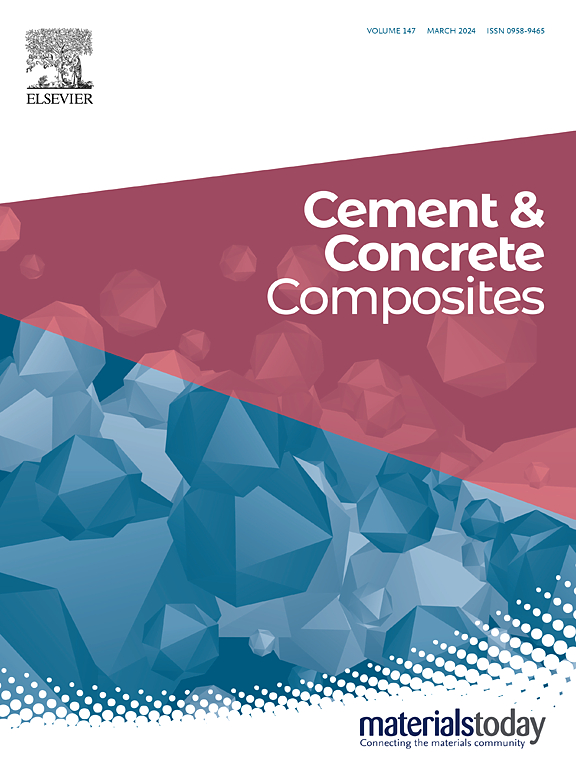Carbonation induced changes in the mechanical performance, water and chloride permeability of Portland cement-slag-limestone ternary cement concretes
IF 13.1
1区 工程技术
Q1 CONSTRUCTION & BUILDING TECHNOLOGY
引用次数: 0
Abstract
Carbonation and chloride-induced deterioration of reinforced concrete can cause infrastructure damage and potential collapse. This study evaluated the impact of carbonation on compressive strength, dimensional stability, water and chloride permeability of concretes made with ternary slag cement containing 10 or 20 wt.% limestone, compared to ground granulated blast furnace slag (GGBFS) blended cement or CEM I. The carbonation rates of binary and ternary concretes were higher than those of CEM I concrete. The existing equation correlating natural and accelerated carbonation coefficients holds for the concretes evaluated and the selected carbonation exposure condition studied. The carbonation depths estimated adopting this correlation are within the limits of the cover depths recommended by the BS 8500–1:2023 for concretes for a 50 years’ service life, when exposed to exposure classes XC3/XC4. Despite the higher carbonation rates, water and chloride permeability of the carbonated ternary and binary slag cement concretes were significantly lower than those of a CEM I equivalent. No clear correlation was identified between compressive strength, porosity, bulk conductivity, water sorption coefficient and carbonation rate. Each of these properties alone did not give a good indication of the overall durability performance of binary or ternary concretes. The results demonstrate that 10 % limestone addition has no adverse effect on carbonation resistance of composite cement concrete. Therefore, it is demonstrated that partial replacement of GGBFS by limestone is a practical and technically sound solution for producing concrete with a reduced clinker content and comparable durability to CEM I or binary GGBFS concretes.
碳化引起硅酸盐水泥-矿渣-石灰石三元水泥混凝土力学性能、水渗透性和氯离子渗透性的变化
碳化和氯化物引起的钢筋混凝土劣化会造成基础设施的破坏和潜在的倒塌。本研究评估了碳化对含有10%或20%石灰石的三元矿渣水泥混凝土的抗压强度、尺寸稳定性、水和氯离子渗透性的影响,并将其与矿渣水泥或矿渣水泥相比较。现有的自然碳化系数与加速碳化系数的关系式适用于所评价的混凝土和所选择的碳化暴露条件。当暴露于XC3/XC4暴露等级时,采用这种相关性估计的碳化深度在BS 8500-1:2023建议的覆盖深度范围内,使用寿命为50年。尽管碳化率较高,但碳化后三元和二元矿渣水泥混凝土的水渗透性和氯离子渗透性明显低于同等的CEM I。抗压强度、孔隙率、体积导电性、吸水系数和碳化率之间没有明显的相关性。这些特性中的每一个单独并不能很好地表明二元或三元混凝土的整体耐久性性能。结果表明,掺量为10%的石灰石对复合水泥混凝土的抗碳化性能无不利影响。因此,用石灰石部分替代GGBFS是一种实用且技术上合理的解决方案,可以生产出熟料含量降低且耐久性与CEM I或二元GGBFS混凝土相当的混凝土。
本文章由计算机程序翻译,如有差异,请以英文原文为准。
求助全文
约1分钟内获得全文
求助全文
来源期刊

Cement & concrete composites
工程技术-材料科学:复合
CiteScore
18.70
自引率
11.40%
发文量
459
审稿时长
65 days
期刊介绍:
Cement & concrete composites focuses on advancements in cement-concrete composite technology and the production, use, and performance of cement-based construction materials. It covers a wide range of materials, including fiber-reinforced composites, polymer composites, ferrocement, and those incorporating special aggregates or waste materials. Major themes include microstructure, material properties, testing, durability, mechanics, modeling, design, fabrication, and practical applications. The journal welcomes papers on structural behavior, field studies, repair and maintenance, serviceability, and sustainability. It aims to enhance understanding, provide a platform for unconventional materials, promote low-cost energy-saving materials, and bridge the gap between materials science, engineering, and construction. Special issues on emerging topics are also published to encourage collaboration between materials scientists, engineers, designers, and fabricators.
 求助内容:
求助内容: 应助结果提醒方式:
应助结果提醒方式:


